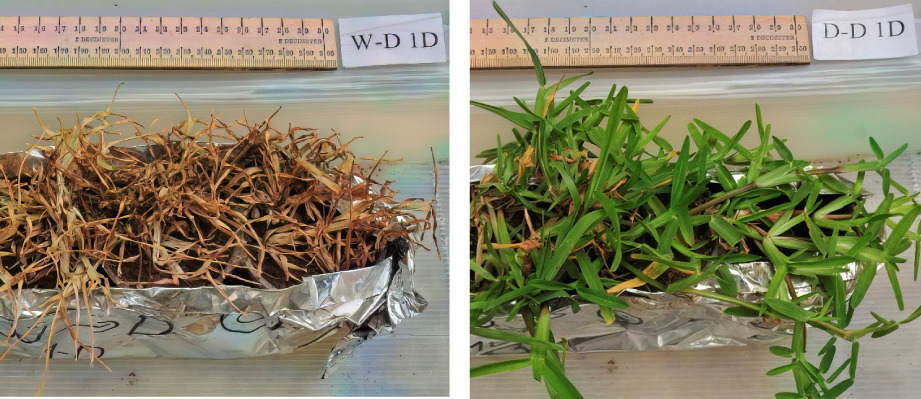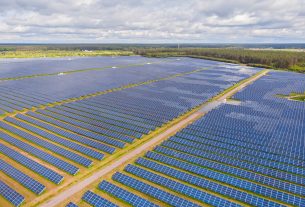The editor’s choice for our January issue is “The ecological implications of interplant drought cuing” by Omer Falik et al. Here, Associate Editor Peter Bellingham discusses the importance of this research:
The importance of interplant communication is a rapidly growing area of research and is becoming more widely appreciated. Interplant communication through networks of hyphae of shared mycorrhizal fungi has had considerable profile in the media and a recent book (Suzanne Simard’s 2022 book, “Finding the Mother Tree”, Penguin). Examples of interplant communication include transport of chemicals through hyphae from plants under attack from herbivores or pathogens to other plants that, in turn, activate production of defence chemicals1,2.
A new study in Journal of Ecology3, by Omer Falik, Shachar Mauda, and Ariel Novoplansky, is innovative in this emerging field. The authors examined interplant communication and explicitly evaluated the ecological consequences of receiving a cue from a stressed, droughted plant (a donor plant4) by neighbouring plants of the same species not subject to drought (receiver plants4).
They used ingenious pot experiments to study this. In the first experiment, involving buffalo grass (Stenotaphrum secundatum), a stoloniferous turf grass, individual plants straddled pots, with roots in separate pots. In this way, drought treatments could be applied to part of one donor plant so that it could then “send” cues from the part rooted in a watered plot to another plant also rooted in that pot and straddling into another watered plot where another plant was growing. The authors refer to the first of these plants as being directly cued and the second, more distant plant, as relay cued. After cuing periods of either 1 or 5 days, the donor plants were removed and all receiver plants were then either droughted or watered for the rest of the experiment.

The results showed strong responses among receiver plants. During a drought lasting 40 days, receiver plants cued by a droughted plant before the subsequent long drought had higher survival than those that had had no cue (and cuing over 5 days produced a stronger effect in receiver plant than cuing of only 1 day). However, there was a cost of cuing for receiver plants when they were in comparative 40-day benign conditions of being watered. In these conditions, relay cued plants had lower shoot biomass and fewer branches than those that had not been cued by droughted plants, indicating a trade-off. Earlier studies by the same authors had shown that cuing by droughted plants had resulted in stomatal closure by receiver plants5 and this may be a reason for reduced growth.
Potential means by which the cues are sent was examined in a second pot experiment. Here the same experimental design of plants straddling plots and donor and receiver plants was employed to investigate whether abscisic acid leaked from roots may be a possible cue. The experiment used cultivars of the garden pea (Pisum sativum) – one the somewhat drought-resistant wild type and the other a mutant with very low production of abscisic acid. Another experiment used treatment with fluridone, which inhibits production of abscisic acid. In both cases, relay-cued pea plants showed evidence that, when abscisic acid was available as a cue (either from wild-type peas or when fluridone was not applied), then their stomatal width was as narrow as a droughted plant. The authors note that this provides evidence of the involvement of abscisic acid in the cuing process, but does not show it to be the exogenous cue.
This study’s results raise interesting questions about population-level trade-offs and when it is advantageous, among different plant life histories, to have the plasticity needed to respond to cues. The authors speculate it is unlikely to apply in annuals. They also note that the responses by receiver plants in terms of reduced biomass could be very disadvantageous if an expected stress, such as a long drought, does not eventuate, which they term a ‘cry-wolf’ scenario.
Overall, these simple, ingenious experiments do indeed demonstrate ecological implications of interplant communication and point the way to mechanistic studies and the need for understanding interactions with soil microbial communities as well. Working on the consequences of interplant drought cuing among long-lived perennials subject to unprecedented “hot droughts6,7 would be challenging but it may point to similar trade-offs as found in this experiment and the potential for population-level resilience.
References
1 Song YY, Zeng RS, Xu JF, Li J, Shen X, Yihdego WG. 2010. Interplant communication of tomato plants through underground common mycorrhizal networks. PLoS ONE 5:e13324.
2 Song YY, Ye M, Li C, He X, Zhu-Salzman K, Wang RL, Su YJ, Luo SM, Zeng RS. 2014. Hijacking common mycorrhizal networks for herbivore-induced defence signal transfer between tomato plants. Scientific Reports 4:3915.
3 Falik O, Mauda S, Novoplansky A 2022. The ecological implications of interplant drought cuing. Journal of Ecology, doi: 10.1111/1365-2745.13991.
4 Gorzelak MA, Asay AK, Pickles BJ, Simard SW 2015. Inter-plant communication through mycorrhizal networks mediates complex adaptive behaviour in plant communities. AoB Plants 7, plv050.
5 Falik O, Mordoch Y, Ben-Natan D, Vanunu M, Goldstein O, Novoplansky A 2012. Plant responsiveness to root–root communication of stress cues. Annals of Botany 110, 271–280.
6 Nolan RH, Gauthey A, Losso A, Medlyn BE, Smith R, Chhajed SS, Fuller K, Song M, Li X, Beaumont LJ, Boer MM 2021. Hydraulic failure and tree size linked with canopy die‐back in eucalypt forest during extreme drought. New Phytologist 230, 1354–1365.
7 Peltier DM, Guo J, Nguyen P, Bangs M, Wilson M, Samuels-Crow K, Yocom LL, Liu Y, Fell MK, Shaw JD, Auty D 2022. Temperature memory and non-structural carbohydrates mediate legacies of a hot drought in trees across the southwestern USA. Tree Physiology 42, 71–85.

